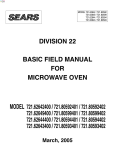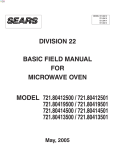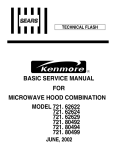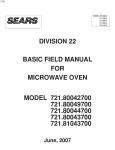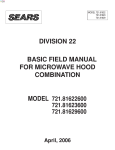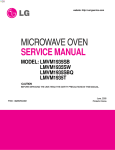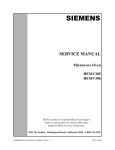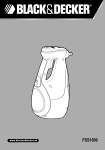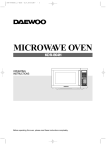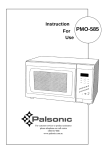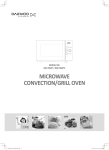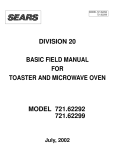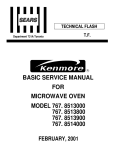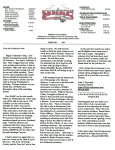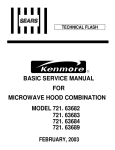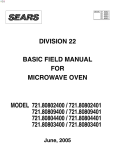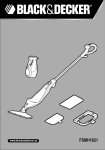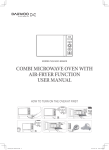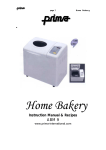Download Service Manual - Appliance Factory Parts
Transcript
ORDER NO. MOD 0106244C1 E2 Service Manual Microwave Oven NN-S251WL NN-S251BL Specifications ITEM APH Power Source 120 V AC, 60 Hz Power Requirement: 13.5 Amps, 1,550 W Output: 1000 W: Full Power (IEC 60705) Microwave Frequency: 2,450 MHz Timer: 99 min. 99 sec. Outside Dimensions: 2915/16"(W) X 167/16"(H) X 153/8"(D) 760mm(W) X 418mm(H) X 385mm(D) Oven Cavity Dimensions: 197/8"(W) X 815/16"(H) X 143/16"(D) 505mm(W) X 227mm(H) X 360mm(D) Weight: Approx. 52 lbs (23.5 kg) Specifications subject to change without notice. 2001 Matsushita Electric Industrial Co., Ltd. All rights reserved. Unauthorized copying and distribution is a violation of law. SAFETY PRECAUTIONS w WARNING This service information is designed for experienced repair technicians only and is not designed for use by the general public. It does not contain warnings or cautions to advise non-technical individuals of potential dangers in attempting to service a product. Products powered by electricity should be serviced or repaired only by experienced professional technicians. Any attempt to service or repair the product or products dealt with in this service information by anyone else could result in serious injury or death. WARNING 1. This product should be serviced only by trained, qualified personnel. 2. Though this product has been manufactured in compliance with: “Federal Performance Standard 21 CFR Subchapter J”(D.H.H.S): U.S.A. models or “Radiation Emitting Devices Act”(Health and Welfare Canada):Canadian models it is very important all repairs should be made in accordance with procedures described in this manual to avoid being exposed to excessive microwave radiation. 3. Check for radiation leakage before and after every servicing according to the “procedure for measuring radiation leakage.” 4. If the unit cannot be repaired on site, advise the customer not to use until unit is repaired. 5. Any serviceman who learns of any accident pertaining to microwave radiation leakage including the oven operating with open door should immediately notify the appropriate address listed below and Center for Devices and Radiological Health, DHHS. IN U.S.A. (PASC) Panasonic Services Company 50 Meadowland Parkway, Secaucus, New Jersey 07094 Attention: Technical Service Division. (201)348-7000 IN PUERTO RICO (PSC) PSC San Gabriel Industrial Park 65th Infantry Ave. Km.9.5 Carolina, Puerto Rico 00985 (787)750-4300 6. There are special components used in the microwave oven which are important for safety. These parts are marked with a w on the replacement parts list. It is essential that these critical parts should be replaced only with the manufacture’s specified parts to prevent microwave leakage, shock, fire, or other hazards. Do not modify the orginal design. PRECAUTIONS TO BE OBSERVED BEFORE AND DURING SERVICING TO AVOID POSSIBLE EXPOSURE TO EXCESSIVE MICROWAVE ENERGY (A) Do not operate or allow the oven to be operated with the door open. (B) Make the following safety checks on all ovens to be serviced before activating the magnetron or other microwave source, and make repairs as necessary: (1) Interlock operation (2) Proper door closing (3) Seal and sealing surfaces (arcing, wear, and other damage) (4) Damage to or loosening of hinges and latches. (5) Evidence of dropping or abuse (C) Before turning on microwave power for any service test or inspection within the microwave generating compartments, check the magnetron, waveguide or transmission line, and cavity for proper alignment, integrity and connections. (D) Any defective or misadjusted components in the interlock, monitor, door seal, and microwave generation and transmission systems shall be repaired, replaced, or adjusted by procedures described in this manual before the oven is released to the owner. (E) A microwave leakage check to verify compliance with the Federal Performance Standard should be performed on each oven prior to release to the owner. FOREWORD Read this Manual carefully. Failure to adhere to or observe the information in this Manual may result in exposing yourself to the Microwave Energy normally contained within the oven cavity. TABLE OF CONTENTS (Page) SAFETY PRECAUTIONS ......................................................................................................... Inside front page SPECIFICATIONS.......................................................................................................................................... 1-1 CAUTIONS ..................................................................................................................................................... 2-1 INSTALLATIONS............................................................................................................................................ 3-1 FEATURE DIAGRAM ..................................................................................................................................... 4-1 CONTROL PANEL ......................................................................................................................................... 4-2 OVERALL CIRCUIT DIAGRAM...................................................................................................................... 5-1 SCHEMATIC DIAGRAM......................................................................................................................... 5-1 MATRIX CIRCUIT FOR TOUCH KEY BOARD ...................................................................................... 5-2 GENERAL INFORMATION FOR SERVICE ................................................................................................... 6-1 GENERAL PRECAUTIONS IN USE ...................................................................................................... 6-1 TRIAL OPERATION ............................................................................................................................... 6-1 FEATURES AND SPECIFICATIONS FEATURES................................................................................. 6-1 SERVICE INFORMATION ............................................................................................................................. 7-1 PRECAUTIONS AND REPAIR SERVICE TIPS ..................................................................................... 7-1 PROCEDURE FOR MEASURING MICROWAVE ENERGY LEAKAGE................................................ 7-2 POWER OUTPUT MEASUREMENT ..................................................................................................... 7-3 DISASSEMBLY INSTRUCTIONS .......................................................................................................... 7-4 INTERLOCK SYSTEM .......................................................................................................................... 7-12 INTERLOCK CONTINUITY TEST .......................................................................................................... 7-14 TEST AND CHECKOUT PROCEDURES AND TROUBLE SHOOTING................................................ 7-15 A. TEST PROCEDURES................................................................................................................ 7-15 B. CHECKOUT PROCEDURES..................................................................................................... 7-18 C. TROUBLE SHOOTING .............................................................................................................. 7-21 SCHEMATIC DIAGRAM OF PCB .................................................................................................................. 8-1 PRINTED CIRCUIT BOARD .................................................................................................................. 8-2 SPECIFICATIONS Rated Power Consumption Frequency Power Supply Rated Current Magnetron Cooling Rectification Door Sealing Safety Devices Magnetron High Voltage Capacitor High Voltage Diode Cook top Lamp Cavity Lamp Timer Tray Overall Dimensions Oven Cavity Size Effective Capacity of Oven Cavity Accessories 1,550W maximum (Microwave oven+Cook top lamps+Ventilation fan) 2,450 MHz ± 50 MHz 120 VAC, 60 Hz 13.5 Amp. (Microwave oven+Cook top lamps+Ventilation fan) Forced Air Cooling Rectification Voltage Double Half-Wave Choke System Oven Cavity Thermostat: Open at 90°C +_ 5°C Fuse(20A) Primary Interlock Switch Secondary Interlock Switch Interlock Monitor 2M214-39F Capacitor: 1.0µF, 2.1 KV AC Diode; 350mA, 9.0 KV 125 V, 30 W 125 V, 30 W Digital, up to 99 mim. 99 sec. (in each cooking stage) Tempered Safety Glass 2915/16”(W)x167/16”(H)x153/8”(D) 197/8”(W)x815/16”(H)x143/16”(D) 1.5 Cu.ft. Owner’s Manual & Cooking Guide, Installation Manual, Exhaust Adapter, Exhaust Damper, Mounting Kit and Two Filters, Rotating Ring Assembly. 1-1 CAUTIONS Unlike other appliances, the microwave oven is high-voltage and high-current equipment. Though it is free from danger in ordinary use, extreme care should be taken during repair. MICROWAVE RADIATION Personnel should not be exposed to the microwave energy which may radiate from the magnetron or other microwave generating device if it is improperly used or connection. All input and output microwave connections, waveguide, flange, and gasket must be secure never operate the device without a microwave energy absorbing load attached. Never look into an open waveguide or antenna while the device is energized. • DO NOT operate on a 2-wire extension cord during repair and use. • NEVER TOUCH any oven components or wiring during operation. • BEFORE TOUCHING any parts of the oven, always remove the power plug from the outlet. • For about 30 seconds after the oven stops, an electric charge remains in the high voltage capacitor. When replacing or checking, you must discharge the high voltage capacitor by shorting across the two terminals with an insulated screwdriver. • Proper operation of the microwave oven requires that the magnetron be assembled to the waveguide and cavity. Never operate the magnetron unless it is properly installed. • Be sure that the magnetron gasket is properly installed around the dome of the tube whenever installing the magnetron. ANTENNA Gasket Chassis Ground COOLING FIN FILAMENT TERMINALS NOTE: Touch chassis first then snort to the capacitor terminals. MAGNETRON CHASSIS GROUND MAGNETRON • Remove your watches whenever working close to or replacing the Magnetron. • DO NOT touch any parts of the control panel circuit. A resulting static electric discharge may damage this P.C.B. • NEVER operate the oven with no load. • NEVER injure the door seal and front plate of the oven cavity. • NEVER put iron tools on the magnetron. • NEVER put anything into the latch hole and the interlock switches area. THE OVEN IS TO BE SERVICED ONLY BY PROPERLY QUALIFIED SERVICE PERSONNEL. 2-1 INSTALLATIONS BEFORE YOU BEGIN, READ THE FOLLOWING INSTRUCTIONS COMPLETELY AND CAREFULLY. PRECAUTIONS ON INSTALLATION A. Plug the power supply cord into a 120V AC, 60Hz, single-phase power source with a capacity of 15A or 20A. B. Avoid placing the unit in a location where there is direct heat or splashing water. C. Install the unit on the mounting plate firmly. D. Place the unit as far away as possible from TV, radio, etc. to prevent interference. GROUNDING INSTRUCTIONS For personal safety, this appliance must be fully grounded at all times. In the event of an electrical short circuit, grounding reduces the risk of electrical shock. The plug must be plugged into an outlet that is properly installed and grounded. CAUTION This unit is equipped with a 3-prong plug for your safety. If the wall outlet is a grounded 3-hole type, the unit will be grounded automatically. Plug with Ground Prong Properly Polarized and Grounded Outlet WARNING Improper use of the grounding plug can result in a risk of electric shock. Do not, under any circumstances, cut or remove the third ground prong from the power cord plug. 3-1 FEATURE DIAGRAM Identification Plate & Menu Label See-through Oven Window Glass Tray Oven Air Vent Door Handle Cover (do not remove) Door Safety Lock System Control Panel Cooktop Light Grease Filter 4-1 CONTROL PANEL 10. Timer Off Pad : Touch this pad to stop timer function. 1. Display Window : The Display includes a clock and indicators to tell you time of day, cooking time settings and cooking functions selected. 11. Function Pad : Touch this pad to change the oven’s default settings for sound, clock, display speed, defrost weight, and demo mode operations. 2. Auto Defrost Pad : Meat, poultry, fish. Touch on pad to select food type and defrost food by weight. 12. Quick Min Pad : Touch this pad to set and start quickly at 100% power level. 3. Auto Reheat Pad : Touch this pad to reheat dinner plate, soup/sause, casserole, roll/muffin. 13. Stop/Reset Pad : Touch this pad to stop oven or clear all entries. 4. Auto Cook Pad : Touch this pad to cook vegetables, rice, or casseroles. 5. Cook Time Pad : Touch this pad to set a cooking time. 14. Start Pad : Touch this pad to start a function. If you open the door after oven begins to cook, retouch START. 6. Power Level Pad : Touch this pad to select a cooking power level. 15. Light On/Night/Off Pad : Touch this pad to turn on the cooktop/countertop light. 7. Number Pads : Touch number pads to enter cooking time, power level, quantities or weights. 16. Fan High/Low/Off Pad : Touch this pad to turn the fan on or off. 8. Timer Pad : Touch this pad to set the kitchen timer. 17. Menu Pads 9. Clock Pad : Touch this pad to enter the time of day. 4-2 OVERALL CIRCUIT DIAGRAM SCHEMATIC DIAGRAM 5-1 MATRIX CIRCUIT FOR TOUCH KEY BOARD 5-2 GENERAL INFORMATION FOR SERVICE FEATURES AND SPECIFICATIONS FEATURES GENERAL PRECAUTIONS IN USE A. Never operate the unit when it is empty. Operating the oven with no load may shorten the life of the magnetron. Whenever cooking dry foods (dried fish, bread, etc.) or a small amount of food, be sure to put a glass of water into the cooking compartment. The glass turntable may become hot after operating, be careful when touching it. B. Aluminum foil should be avoided because it will disrupt cooking and may cause arcing. However, small pieces may be used to cover some parts of food to slow the cooking. Any aluminum foil used should never be closer than 2.5 cm to any side wall of the oven. A. The safety systems incorporated in this model are: (1) Primary interlock switch (2) Secondary interlock switch (3) Interlock monitor switch (4) Choke system (5) Magnetron thermal fuse (6) Oven cavity thermostat (Note: This thermostat located on the oven cavity will open and stop the unit from operation only if a high temperature is reached, such as, a fire created by overcooking food.) B. Any one of 10 power output levels ranging 100W to 1000W can be selected by the touch control and electronic computer system. TRIAL OPERATION After installation, the following sequences and results should be checked carefully. A. Put a container filled with water (about 1 liter) into the oven, and close the door tightly. B. Set cooking time for 10 minutes by touching “1” and then “0” three times. “1, 0, 0, 0” appears in the display window. C. Touch the START key. Make sure the cavity light comes on. The unit will begin cooking and the display window will show the time counting down by seconds. D. After about 5 minutes, make sure the primary interlock switch, the secondary interlock switch and the interlock monitor switch operate properly by opening and closing the door several times. Touch the START key each time the door is closed. E. Continue operating the unit. Four long beep sound signal is heard when the time is up. The unit will shut off automatically. F. Confirm the water is hot. G. Finally, measure the output power according to “POWER OUTPUT MEASUREMENT” on page 7-3. 6-1 SERVICE INFORMATION PRECAUTIONS AND REPAIR SERVICE TIPS PRELIMINARY (3) Do not operate the unit until it is completely repaired, if any of the following conditions exist. The unit must not be operated. (a) The door does not close firmly. (b) The hinge is broken. (c) The door seal is damaged. (d) The door is bent or warped, or there is any other visible damage on the unit that may cause microwave energy leakage. NOTE: Always keep the seal clean. (e) Make sure that there are no defective parts in the interlock mechanism. (f) Make sure that there are no detective parts in the microwave generating and transmission assembly (especially waveguide). A. SINCE NEARLY 2,100 VOLTS EXISTS IN SOME CIRCUITS OF THIS UNIT REPAIRS SHOULD BE CARRIED OUT WITH GREAT CARE. The filament leads of magnetron carry High Voltage with respect to ground. Extreme caution must be exercised. Never plug the unit into a power source to determine which component is defective in high voltage section. B. TO AVOID POSSIBLE EXPOSURE TO MICROWAVE ENERGY LEAKAGE, THE FOLLOWING PRECAUTIONS MUST BE TAKEN BEFORE SERVICING. (1) Before the power is applied: (a) Make sure the primary interlock switch, the secondary interlock switch and the interlock monitor switch operate properly by opening and closing the door several by opening and closing the door several times. (b) Make sure the perforated screen and the dielectric choke of the door are correctly and firmly mounted. (4) The following items should be checked after the unit is repaired: (a) The interlock monitor switch is connected correctly and firmly. (b) The magnetron gasket is properly positioned and mounted. (c) The waveguide and the oven cavity are intact. (no microwave energy leakage) (d) The door can be properly closed and the safety switches work properly. (e) The unit must stop when the door is opened or the time is up. (2) After power is applied: (a) Make sure the interlock switch mechanism is operating properly by opening and closing the door. (b) Check microwave energy leakage must bebelow the limit of 5 mW/cm2. The unit must not be operated with any of the above components removed or by-passed. (All service adjustments should be made for minimum microwave energy leakage readings). 7-1 PROCEDURE FOR MEASURING MICROWAVE ENERGY LEAKAGE (D) Tap the start pad or set the timer and with the magnetron oscillating, measure the leakage by holding the probe perpendicular to the surface being measured. (1) Measurement with the outer panel removed. Whenever you replace the magnetron, measure for radiation leakage before the outer panel is installed and after all necessary components are replaced or adjusted. Special care should be taken in measuring around the magnetron. WARNING Check for radiation leakage after every servicing. Should the leakage be more than 2 mW/cm2 inform PASC immediately. After repairing or replacing any radiation safety device, keep a written record for future reference, as required by D.H.H.S. regulation. This requirement must be strictly observed. In addition, the leakage reading must be recorded on the service repair ticket while in the customer’s home. NOTE: The U.S. Government standard is 5mW/cm2 while in the customer s home. 2mW/cm2 stated here is our own voluntary standard. WARNING Avoid contacting any high voltage parts. 1. Equipment (2) Measurements with a fully assembled oven. After all components, including outer panel are fully assembled, measure for radiation leakage around the door periphery, the door viewing window, the exhaust opening and air inlet openings. • Electromagnatic radiation monitor • Glass thermometer 212°F or 100°C • 600cc glass beaker 2. Procedure for measuring radiation leakage Note before measuring. (1) Do not exceed meter full scale deflection. Leakage monitor should initially be set to the highest scale. (2) To prevent false readings the test probe should be held by the grip portion of the handle only and moved along the shaded area in Figure no faster than 1 inch/sec (2.5cm/sec). (3) Leakage with the outer panel removed ...... less than 5mW/cm2. (4) Leakage for a fully assembled oven with door normally closed ...... less than 2mW/cm2 (1mW/cm2 for Canada). (5) Leakage for a fully assembeld oven [Before the latch switch (primary) is interrupted] while pulling the door ...... less than 2mW/cm2. (A) Pour 275°±15cc (9ozs°±1/2oz) of 20°±5°C (68°±9°F) water in a beaker which is graduated to 600cc , and place in the center of the oven. (B) Set the radiation monitor to 2450MHz and use it following the manufacturer’s recommended test procedeur to assure correct results. (C) When measuring the leakage, always use the 2 inch (5cm) spacer supplied with the probe. 3. Record keeping and notification after measurement (A) After any adjustment or repair to a microwae oven, a leakage reading must be taken. Record this leakage reading on the repair ticket even if it is zero. A copy of this repair ticket and the microwave leakage reading should be kept by repair facility. (B) Should the radiation leakage be more than 2mW/cm2 after determining that all parts are in good condition, functoning properly, and genuine replacement parts as listed in this manual have been used, immediately notify PASC. 4. At least once a year, have the radiation monitor checked for calibration by its manufacturer. Move probe along shaded area. Probe scanning speed Less than 2.5 cm/sec. ( 1 in/sec) 7-2 MEASUREMENT WITH THE OUTER CASE REMOVED NOTE WHEN MEASURING (1) Do not exceed meter full scale deflection. (2) The test probe must be removed no faster than 1 inch/sec (2.5cm/sec) along the shaded area, otherwise a false reading may result. (3) The test probe must be held with the grip portion of the handle. A false reading may result if the operator’s hand is between the handle and the probe. (4) When testing near a corner of the door, keep the probe perpendicular to the surface making sure the probe horizontally along the oven surface, this may possibly cause probe damage. (1) When you replace the magnetron, measure for microwave energy leakage before the outer case is installed and after all necessary components are replaced or adjusted. Special care should be taken in measuring the following parts. - Around the magnetron - The waveguide WARNING: AVOID CONTACTING ANY HIGH VOLTAGE PARTS. MEASUREMENT WITH A FULLY ASSEMBLED OVEN RECORD KEEPING AND NOTIFICATION AFTER MEASUREMENT (1) After all components, including the outer panels, are fully assembled, measure for microwave energy leakage around the door viewing window, the exhaust opening and air inlet openings. (2) Microwave energy leakage must not exceed the values prescribed below. (1) After adjustment and repair of any microwave energy interruption or microwave energy blocking device, record the measured values for future reference. Also enter the information on the service invoice. (2) Should the microwave energy leakage not be more than 2 mW/cm2 after determining that all parts are in good condition, functioning properly and genuine replacement parts which are listed in this manual have been used. (3) At least once a year, have the electromagnetic energy leakage monitor checked for calibration by its manufacturer. NOTES: Leakage with the outer panels removed less than 5 mW/cm2. Leakage for a fully assembled oven (“Before the latch switch (primary) is interrupted”) with the door in a slightly opened position - less than 2 mW/cm2. POWER OUTPUT MEASUREMENT (1) Microwave power output measurement is made with the microwave oven supplied at its rated voltage and operated at its maximum microwave power setting with a load of (1000±5) g of potable water. (2) The water is contained in a cylindrical borosilicate glass vessel having a maximum material thickness of 1/8” (3 mm) and an outside diameter of approximately 7.6” (190mm). (3) The oven and the empty vessel are at ambient temperature prior to the start of the test. (4) The initial temperature (T1) of the water is (10±2)°C (50°F) It is measured immediately before the water is added to the vessel. After addition of the water to the vessel, the load is immediately placed on the center of the turntable which is in the lowest position and the microwave power switched on. (5) The time T for the temperature of the water to rise by a value ∆ T of (10±2)°K is measured, where T is the time in seconds and ∆T is the temperature rise. The initial and final water temperatures are selected so that the maximum difference between the final water temperature and the ambient temperature is 5°K. (6) The microwave power output P in watts is calculated from the following formula : P= 4187 x (∆T) T is measured while the microwave generator is operating at full power. Magnetron filament heat-up time is not included. (about 3 sec) (7) The water is stirred to equalize temperature throughout the vessel, prior to measuring the final water temperature. (8) Stirring devices and measuring instruments are selected in order to minimize addition or removal of heat. WATER LOAD TURNTABLE NOTES: For simple test of microwave power output, conduct it by heating one litter water for one minute, minimum temperature rise should be 15.4°F(8.6°C) 7-3 DISASSEMBLY INSTRUCTIONS IMPORTANT NOTES: (4) Remove 3 screws securing the circuit board. UNIT MUST BE DISCONNECTED FROM ELEC-TRICAL OUTLET WHEN MAKING REPAIRS, RE-PLACEMENTS, ADJUSTMENTS AND CONTIN-UITY CHECKS. WAIT AT LEAST ONE MINUTE, UNTIL THE HIGH VOLTAGE CAPACITOR IN THE HIGH VOLTAGE POWER SUPPLY HAS FULLY DISCHARGED. THE CAPACITOR SHOULD BE DISCHARGED BY USING INSULATED WIRE - I.E. TEST PROBE CONNECTED TO 10K-OHM RESISTOR IN SERIES TO GROUND. WHEN RECONNECTING THE WIRE LEADS TO ANY PART, MAKE SURE THE WIRING CONNE-CTIONS AND LEAD COLORS ARE CORRECTLY MATCHED ACCORDING TO THE OVERALL CIR-CUIT DIAGRAM. (ESPECIALLY SWITCHES AND HIGH VOLTAGE CIRCUIT.) Circuit Board BEFORE A. GRILLE HAVE TO REMOVE FIRST. Figure 2 A. REMOVING POWER AND CONTROL CIRCUIT BOARD (Figures 1, 2 and 3) (1) Remove a screw securing the control panel assembly to the oven cavity. (2) Remove the control panel with pushing it upward. (3) Remove the connector (CN1) and wire leads (Relay7) from the circuit board. (5) Remove the FPC connector from the terminal socket following “HOW TO REMOVE THE FPC CONNECTOR” on the next page. (6) Remove the circuit board from the control bracket carefully. Control Panel Screw Control Bracket FPC Connector(S1) Power Transformer Circuit Board Relay 7 (Relay 7) (CN1) Figure 3 Figure 1 7-4 HOW TO REMOVE THE F.P.C. CONNECTOR HOW TO INSERT THE F.P.C. CONNECTOR Follow the steps below as illustrated in Figures 4 and 5 to remove the F.P.C. connector. Follow the steps below as illustrated in Figures 6 and 7 to insert the F.P.C. connector. (1) Insert the F.P.C. connector into the terminal socket securely with the fingers. (2) Hold the plastic fastener with thumb and forefinger of the other hand, and push it slowly into the terminal socket. (Figure 6) NOTE: When reconnecting the F.P.C connector make sure that the holes on the F.P.C. connector are properly engaged with the hooks on the plastic fastener (3) Lock the level of the plastic fastener into the hook of the terminal socket securely by releasing the fingers. (Figure 7) (1) Hold the edges of the plastic fastener with thumb and forefinger. (Figure 4) (2) Lift up the lever of the plastic fastener from the terminal socket by lightly pressing the lever end with forefinger. (Figure 5) (3) Remove the F.P.C. connector from the terminal socket. Plastic fastener Plastic fastener Hook Holes F.P.C. Connector Terminal socket F.P.C. Connector Figure 4 Terminal socket Figure 6 Plastic fastener Hook Plastic fastener Holes F.P.C. Connector F.P.C. Connector Terminal socket Figure 5 Terminal socket Figure 7 7-5 B. REMOVING THE OUTER CASE(Figure 8) (1) Remove the vent grille by removing two screws securing it to the outer case. (2) Remove two screws securing it to the front bracket. (3) Remove two screws securing it to the air duct. (4) Remove the wall mounting plate by removing the two screws securing it to the outer case. (5) Remove the base plate by removing six screws securing it to the outer case. Remove the Mount from the out case by removing two screws securing it to the outer case and one screw securing it to the ventilation motor ASS'Y and cavity. (6) Remove the power cord cover from outer case by removing a screw. Mount Power cord Door Mounting Plate Outer Case Base Plate Vent Grille Control Panel Figure 8 7-6 C REMOVING THE DOOR INTERLOCK SWITCHES (Figures 9,10) (1) Disconnect the wire leads from the interlock switches. (2) Remove two screws securing the Door Hook. (3) Make necessary replacements and check microwave energy leakage according to “ADJUSTMENT PROCEDURE” on page 7-12. Door Hook Secondary Interlock Switch Door Hook Secondary Interlock Switch WH(from H.V.Transformer) WH(from Monitor S/W) WH(from Oven Thermostat) WH(from Cooktop lamp Interlock Monitor Switch Primary Interlock Switch Monitor Interlock Switch YL(from turntable motor) WH(from Secondary switch) Figure 10 RD(from Ry 7) WIRE COLOR Primary Interlock Switch SYMBOL WH YL RD GN N.P. GN(from P.C.B) YL(from P.C.B) Figure 9 7-7 COLOR WHITE YELLOW RED GREEN Not Provided NOTES: • When removing the magnetron, make sure that its dome does not hit any adjacent parts, or it may be damaged. D. REMOVING MAGNETRON (Figures 11 Through 13) (1) (2) (3) (4) (5) Remove vent grille. Remove mount. Remove outer case. Disconnect the wireleads. Remove the Magnetron very carefully. • When replacing the magnetron, be sure to install the magnetron gasket in the correct position and be sure that the gasket is in good condition. • After replacing the magnetron, check for microwave energy leakage with a survey meter. Microwave energy leakage must be below the limit of 5 mW/cm2. (All service adjustments should be made for minimum microwave energy leakage readings.) mount Outer Case vert grille Magnetron Figure 11 Figure 13 7-8 Figure 12 E. REMOVING DOOR (Figure 14) (1) Remove the vent grille by removing two screws securing it to the Outer Case loosening. (2) Lift up and draw the door. NOTES: • After replacing the door, be sure to check that the primary interlock switch, the secondary interlock switch and the interlock monitor switch is in good operating normally. • After replacing the door, check for microwave energy leakage with a survey meter. Microwave energy leakage must be below the limit of 5mW/cm2. (With a 275 ml water load) Figure 14 F. DISASSEMBLING DOOR (Figure 15) (1) Remove the dielectric choke by using knife blade or small screw driver, etc. (2) Remove two screws securing it to the door handle. CAUTION: Be careful not to damage door seal plate with the screwdriver. Door Screen Figure 15 7-9 G. ASSEMBLING DOOR (1) When mounting the door assembly to the oven assembly, be sure to adjust the door assembly parallel to the chassis. Also adjust so the door has no play between the inner door surface and oven frame assembly. If the door assembly is not mounted properly, microwaves may leak from the clearance between the door and the oven. (3) Carefully pull the ventilation motor ASS'Y out of the microwave oven. (See Figure 18) Space Figure 18 H. REMOVING THE VENTILATION FAN ASS'Y (1) Remove the mounting plate by removing two screws securing it to the back plate. (See Figure 16) (2) Remove the two screws securing the MOUNT and one screw securing the ventilation fan ASS'Y. (See Figure 17) Figure 16 MOUNT Figure 17 7-10 NOTES: • Remove the leadwire from the turntable motor VERY CAREFULLY. • Be sure to grasp the connector not the wires when removing. I. REMOVING THE TURNTABLE MOTOR (1) Remove the turntable. (2) Remove the turntable shaft VERY CAREFULLY with a slotted screwdriver. (Figure 19) (3) Remove the base plate by removing 6 screws securing it to the oven cavity. (Figure 20) (4) Disconnect the leadwire from the turntable motor terminals. (5) Remove the 2 screws securing the turntable motor to the oven cavity ASS'Y. (Figure 21) Figure 19 Base Plate Figure 20 Terminals Turntable Motor Figure 21 7-11 INTERLOCK SYSTEM INTERLOCK SYSTEM INTERLOCK MECHANISM The door lock mechanism is a device which has been specially designed to eliminate completely microwave activity when the door is opened during cooking and thus to prevent the danger resulting from the microwave leakage. ADJUSTMENT PROCEDURES To avoid possible exposure to microwave energy leakage, adjust the door latches and interlock switches, using the following procedure. CHECK THE DOOR LATCH AND SWITCH CLOSING. NOTE: The outer cover of the microwave oven is removed. The Interlock Monitor and Primary Interlock Switch act as the final safety switch protecting the user from microwave energy. The terminals between “COM” and “NC” of the Interlock Monitor must close when the door is opened. After adjusting the Interlock Monitor Switch, make sure that it is correctly connected. Mounting of the primary/monitor/secondary switches to the latch board. (1) Set the microwave oven on its side so that you can see the latch board and the switches, as shown in Figure 22-a. (2) Close the door tightly and check gaps A and B to be sure they are no more than 1/64” (0.5 mm). See Figure 22-b for close-up view of gaps A and B (door latches). If all gaps are less than 1/64” (0.5 mm), adjustment of the latch board may not be necessary. Go to Steps 5 and 6 to check the sequence of the switches. Door Hook NOTE: To correct sequence of the Primary Interlock Switch, Secondary Interlock Switch and the Interlock Monitor Switch is very important. If any gap is larger than 1/64” (0.5 mm), you will need to adjust the latch board”. Go to step 3 and follow all steps in order. Secondary Interlock Switch ADJUST THE LATCH AND SWITCH CLOSING (3) Loosen the two screws holding the plastic latch board as shown. Interlock Monitor Switch (4) With the oven door closed tightly, move the latch board upward toward the top of the oven and/or away from the door latch until the gaps are less than 1/64” (0.5 mm). Hold the latch board tightly in this position until you check the sequence of the switches in steps 5 and 6. Primary Interlock Switch Figure 22-a LATCH 0-1/64" Figure 22-b Door Hook 0-1/64" 7-12 TEST THE LATCH AND SWITCH SEQUENCE (5) Open the oven door slowly. Watch the door latch, the Secondary Switch. Release Rod and Lever on the switches to make sure they are zero to the body of the switches in the following sequence: (7) When you achieve the proper sequence of switches in Steps 5 and 6, tighten the latch board screws at that point. TEST THE MICROWAVE ENERGY LEAKAGE - Primary Interlock Switch - Secondary Interlock Switch - Interlock Monitor Switch Make sure the microwave energy leakage is below the limit of 1mW/cm2 (with a 275 ml water load) and 5mW/cm2 (with a 275 ml water load without the cabinet) when measured with a survey meter. Adjust the latch board until the switches operate in this sequence. See Steps 3 and 4. (6) Close the oven door slowly and be sure it is tightly closed. Watch the three switches to make sure they are zero to the body of the switches in the following sequence: - Interlock Monitor Switch - Primary Interlock Switch - Secondary Interlock Switch NOTE: The Interlock Monitor Switch is an added safety check on the Primary and Secondary Interlock Switches. If the Primary and Secondary Interlock Switches allow the oven to operate with the door open, the Monitor Switch will blow the fuse. 7-13 INTERLOCK CONTINUITY TEST A. PRIMARY INTERLOCK SWITCH TEST B. SECONDARY INTERLOCK SWITCH TEST Disconnect the wire lead from the secondary switch. Connect the ohmmeter leads to the common (COM) and normally open (NO) terminals of the switch. The meter should indicate a open circuit in the door open condition. When the door is closed, meter should indicate an closed circuit. When the secondary switch operation is abnormal, make the necessary adjustment or replace the switch only with the same type of switch. When the door is opened slowly, an audible click should be heard at the same time or successively at intervals and the latches should activate the switches with an audible click. If the latches do not activate the switches when the door is closed, the switches should be a adjusted in accordance with the adjustment procedure. Disconnect the wire lead from the primary switch. Connect the ohmmeter leads to the common (COM) and normally open (NO) terminal of the switch. The meter should indicate an open circuit in the door open condition. When the door is closed, the meter should indicate a closed circuit. When the primary switch operation is abnormal, make the necessary adjustment or replace the switch only with the same type of switch. COMPONENTS SWITCHES (Wire leads removed) C. MONITOR SWITCH TEST Disconnect the wire lead from the monitor switch. Connect the ohmmeter leads to the common (COM) and normally closed (NC) terminals of the switch. The meter should indicate closed circuit in the door open condition. When the door is closed, meter should indicate an open circuit. When the monitor switch operation is abnormal, replace with the same type of switch. NOTE: After repairing the door or the interlock system, it is necessary to do this continuity test before operating the oven. TEST PROCEDURE Check for continuity of the switch with an Ohm-meter Primary Switch Monitor Switch Secondary Switch RESULTS Door open Door closed NO COM NC COM NO COM NOTE : After checking for the continuity of switches, make sure that they are connected correctly. WARNING : FOR CONTINUED PROTECTION AGAINST EXCESSIVE RADIATION EMISSION, REPLACE ONLY WITH IDENTICAL REPLACEMENT PARTS. TYPE NO. SZM-V16-FA-63 OR VP-533A-OF OR V-5230Q FOR PRIMARY SWITCH TYPE NO. SZM-V16-FA-62 OR VP-532A-OF OR V-5220Q FOR MONITOR SWITCH TYPE NO. SZM-V15-FA-63 7-14 TEST AND CHECKOUT PROCEDURES, AND TROUBLE SHOOTING - CAUTIONS - DISCONNECT THE POWER SUPPLY CORD FROM THE WALL OUTLET WHENEVER REMOVINGING THE CABINET FROM THE UNIT. PROCEED WITH THE TESTS ONLY AFTER DISCHARGING THE HIGH VOLTAGE CAPACITOR AND REMOVING THE WIRE LEADS FROM THE PRIMARY WINDING OF THE HIGH VOLTAGE TRANSFORMER. (SEE FIGURE 23) Filament Winding Secondary Winding - ALL OPERATIONAL CHECKS WITH MICROWAVE ENERGY MUST BE DONE WITH A LOAD (1 LITER OF WATER IN CONTAINER) IN THE OVEN. Primary Winding Figure 23 A. TEST PROCEDURES COMPONENTS TEST PROCEDURES 1) Measure the resistance: Across the filament terminals of the magnetron with an ohm-meter on Rx1 scale. MAGNETRON (Wire leads are removed) HIGH-VOLTAGE TRANSFORMER (Wire leads are removed) 2) Measure the resistance: Between each filament terminal of the magnetron and the chassis ground with an ohm-mater on high test scale. RESULTS Normal reading: Less than 1 ohm. Normal reading: Infinite ohms. NOTE: Replace the magnetron, if the magnetron checks and all of the high voltage component tests are good, but the unit still does not heat a load. 1) Measure the resistance: With an ohm-meter on Rx1 scale. a. Primary winding; b. Filament winding; c. Secondary winding; Normal readings: Approx. 0.3 to 0.5 ohm. Less than 0.1 ohm. Approx. 65 to 120 ohms. 2) Measure the resistance: With an ohm-meter on highest scale. a. Primary winding to ground; b. Filament winding to ground; Normal readings: Infinite ohms. Infinite ohms. NOTE: A MICROWAVE ENERGY LEAKAGE TEST MUST ALWAYS BE PERFORMED WHEN THE UNIT IS SERVICED FOR ANY REASON. 7-15 COMPONENTS TEST PROCEDURES Measure the resistance: (1) Terminal to terminal Normal reading: Momentarily indicates several ohms, and then gradually returns to infinite ohms. Abnormal reading: Indicates continuity or infinite ohms from the beginning. Ohmmeter HIGH-VOLTAGE CAPACITOR RESULTS Figure 24-a Normal readings: Infinite. (2) Terminal to case Abnormal reading: Indicates continuity. Ohmmeter Figure 24-b Normal readings: continuity. Measure the continuity: (1) Forward Abnormal reading: Infinite. Ohmmeter Note : Meter reading depend on the battery in the Meter. Figure 25-a HIGH-VOLTAGE DIODE Normal readings: Infinite. (1) Reverse Abnormal reading: continuity. Ohmmeter Figure 25-b 7-16 COMPONENTS TEST PROCEDURES Measure the resistance between terminal pins of connector KEY CONNECTOR. NOTE: When reconnecting the FPC connector, make sure that the holes on the FPC connector are properly engaged with hooks on the plastic fastener. MATRIX CIRCUIT FOR TOUCH KEY BOARD RESULTS Resistance value When touched Less than More than 400 ohms 1 mega ohm FPC CONNECTOR Top CONNECTOR(KEY CON) (For detail matrix circuit of each model, refer to page 5-2.) TOUCH KEY BOARD Figure 27 Figure 26 7-17 When not touched COMPONENTS TEST PROCEDURES Check for continuity of relay 7 with an ohm-meter. (Remove wire leads from relay 7 and operate the unit.) Relay 7 RELAY7 Figure 28 RESULTS POWER LEVEL 1 4 sec 18 sec 2 6 sec 16 sec 3 8 sec 14 sec 4 10 sec 12 sec 5 12 sec 10 sec 6 14 sec 8 sec 7 16 sec 6 sec 8 18 sec 4 sec 9 20 sec 2 sec 10 22 sec 0 w CAUTION: The relay connector 2(White) and 5(Red) must be correctly connected Relay 6. These two connectors are not interchangeable. NOTES: • A MICROWAVE ENERGY TEST MUST ALWAYS BE PERFORMED WHEN THE UNIT IS SERVICED FOR • MAKE SURE THE WIRE LEADS ARE IN THE CORRECT POSITION. • WHEN REMOVING THE WIRE LEADS FROM THE PARTS, BE SURE TO GRASP THE CONNECTOR, NOT THE WIRES. B. CHECKOUT PROCEDURES (1) CHECKOUT PROCEDURES FOR FUSE BLOWING CAUTION: REPLACE BLOWN FUSE WITH 20 AMPERE FUSE. PROBLEMS CAUSES Fuse blows immediately after the door is closed. Fuse blows immediately after the door is opened. Fuse blows when the door is closed and START key is touched. Improper operation of the primary interlock, secondary interlock switches and/or the interlock monitor switch. Malfunction of the high voltage transformer; the high voltage capacitor including the diode, the magnetron, the blower motor or the circuit board. NOTES: • If the fuse is blown by an improper switch operation, replace all switches and the fuse at the same time. After replacing the defective switches with new ones, make sure that they are correctly connected. • Check for microwave energy leakage according to INTERLOCK ADJUSTMENT PROCEDURES on page 7-12 when the primary interlock, secondary interlock switches and/or the interlock monitor switches are adjusted or replaced. 7-18 (2) CHECKOUT PROCEDURES FOR RELAY. - PROBLEM (A) Vent fan motor and oven lamp turn on without touching START key when the door is closed. NO GOOD YES Remove the mate connector of I/O CON from the circuit board. Does the unit still operate? NO Replace the circuit board YES Defective RELAY7 Replace RELAY7 - PROBLEM (B) Vent fan motor and oven lamp turn on When the door is closed and START key is touched. NO YES GOOD Measure the voltage at pin NO. 4, 5, 6 of U01 Voltage reading: 0 Vdc NO Replace the circuit board YES Defective RELAY7 or poor connection of RELAY7 Replace RELAY7 or correct the connection. 7-19 (3) CHECKOUT PROCEDURES FOR CIRCUIT BOARD The following symptoms indicate a defective circuit board. 1) 1) The start function fails to operate but the high voltage Systems, the interlock switches, the door sensing and the relay check good. 2) The unit with a normal relay continuously operates. 3) Proper temperature measurement is not obtained. 4) The buzzer does not sound or continues to sound. 5) Some segments of one or more digits do not light up, or they continue to light up, or segments light when they should not. 6) 7) 8) 9) Wrong figures appear. The figures of all digits. Some of the indicators do no flicker light up. The clock does not keep time properly. NOTE: A MICROWAVE ENERGY LEAKAGE TEST MUST ALWAYS BE PERFORMED WHEN THE UNIT IS SERVICED FOR ANY REASON. 7-20 7-21 Measure voltage between pin 1 and pin 3 of connector CN1. WH RD 1 Measure resistance of touch key board after removing connector S1. (See page 7-4 and 7-17) 120 120 Resistance incorrect Normal resistance Voltage incorrect 0 120V 0 Replace touch key board. Check contact of connector S1 Correct connections Replace circuit board Check: 1. POWER SUPPLY 2. FUSE (See “CHECKOUT PROCEDURES FOR FUSE BLOWING: on page 7-18) 3. OVEN CAVITY THERMOSTAT PROBLEM - B: Display does not show correct numbers and/or correct indications when programmed. 1 PROBLEM - A: “PLEASE SET TIME OF DAY” does not appear in display window when power supply cord is plugged into wall outlet. C. TROUBLE SHOOTING Before following this troubleshooting read “TRIAL OPERATION” on page 6-1. • “DISPLAY” Problems, “A” thru “C” • “HELP UP” Problems, “D” thru “E” • “BUZZER Problems, “F” Normal touch key board Poor contact Contact ok Normal resistance Normal circuit board Correct seating Replace circuit board Normal contact Normal circuit board Runs Runs Runs Runs Runs 7-22 2 1 Measure resistance of H.V.Transformer (see page 7-15) Check the contact of relay 7(see page 7-18) Normal resistance Resistance incorrect Contact OK NO continuity Replace circuit board Replace H.V.T. Normal circuit board Check the continuity of H.V.C. (see page 7-16) Normal H.V.T. Check contact of connector S1 Check: 1. PRIMARY AND SECONDARY INTERLOCK SWITCHES 2. THERMOSTAT PROBLEM - E: Unit does not heat up even if display counts down when START key is touched for “HIGH POWER” cooking. Normal resistance Resistance incorrect Contact OK Poor contact Check the continuity of H.V.D. (see page 7-16) Normal contact Normal Normal H.V.C. Replace Magnetron Replace H.V.D. Normal circuit board Abnormal Replace H.V.C. Replace circuit board Correct seating Normal Magnetron Normal H.V.D. Runs Runs Runs Runs Runs Runs Runs 7-23 1 Check normal operation circuit board PROBLEM - F: No buzzing when touching the key, between stages or at end of cooking Replace circuit board Normal circuit board Runs 7-24 Check: 1. POWER SUPPLY 2. FUSE Check the contact of oven thermostat 1 Contact OK NO contact Check contact of connector S1 (see page 7-4) Replace oven thermostat Contact OK Poor contact PROBLEM - G: Ventilation fan does not operate when FAN HIGH/LOW key is touched. Replace circuit board Correct seating Normal circuit board Normal contact NO runs Replace ventilation motor ASS Y Normal ventilation motor ASS Y Runs Runs Runs Runs SCHEMATIC DIAGRAM OF P.C.B 8-1 PRINTED CIRCUIT BOARD 8-2 EXPLODED VIEW MODEL : NN-S251 DOOR PARTS 3 4 2 1 6 8 65 7 9 5 -1- ESCUTCHEON BASE ASSEMBLY 14 11 12 67 10 66 60 13 -2- OVEN CAVITY PARTS 21 63 65 66 66 17 66 18 16 15 27 23 25 26 22 24 20 64 22 19 64 -3- DOOR HOOK PARTS 28 31 61 29 32 69 30 -4- INTERIOR PARTS(I) 33 60 60 35 44 60 65 36 63 42 39 63 37 62 60 43 60 41 34 40 38 63 -5- INTERIOR PARTS (II) 45 65 53 48 46 51 65 50 49 54 55 47 52 60 -6- INSTALLATION PARTS 56 59 58 57 VINYL BAG -7-












































